8 Breathing Exercises You Can Use to Relax
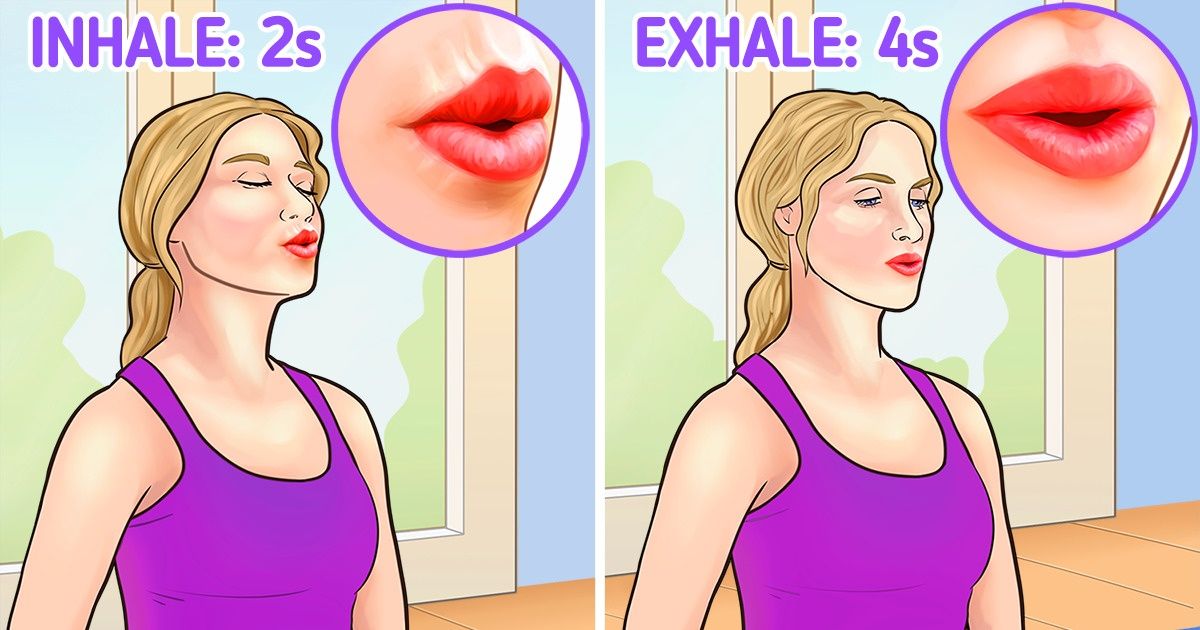
Breathing techniques can reduce stress and anxiety, relax the body, and quiet the mind. Implementing and practicing these frequently and in the right way can help a person sleep better, have more energy in the morning, and improve their breathing capacity.
At 5-Minute Crafts we would like to share a few easy breathing exercises with you that you can practice every day. Choose the one that best suits your needs at any given moment.
Technique 1: Pursed lips breathing
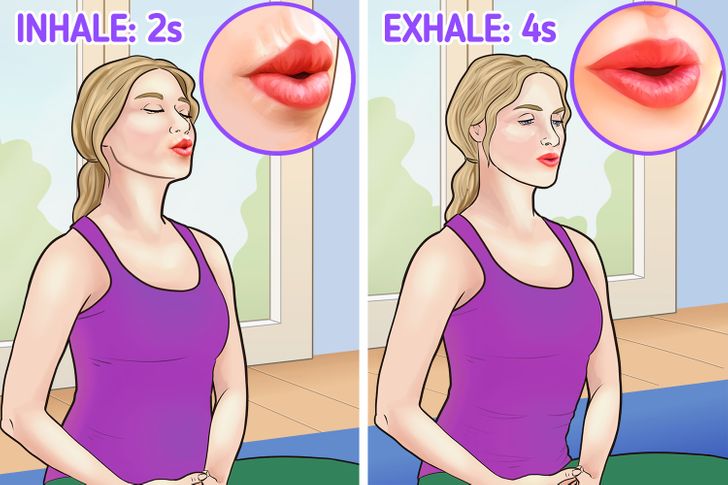
The goal of this technique is to slow down your breathing rhythm and help you control this movement better. Not only that, but also deep, steady breaths have a relaxing effect on the entire body, which can help you decrease stress and anxiety levels. It can come in handy if you use this technique during activities that require an intense breathing rhythm, like bending over, climbing stairs, or lifting heavy objects.
- Sit or lie down with your back straight, while at the same time keeping your shoulders relaxed.
- Inhale deeply through your nose for 2 seconds. Try to bring as much air as possible into your abdomen.
- Squeeze your lips together and pretend that you are blowing on a wound on a child’s arm, then exhale very slowly (the exhalation time should last twice as long as the inhalation time).
- Practice this method 4 or 5 times a day and try to double the time of the breaths (from 2 seconds to 4 and then from 4 to 8).
Technique 2: Diaphragmatic breathing (abdominal)
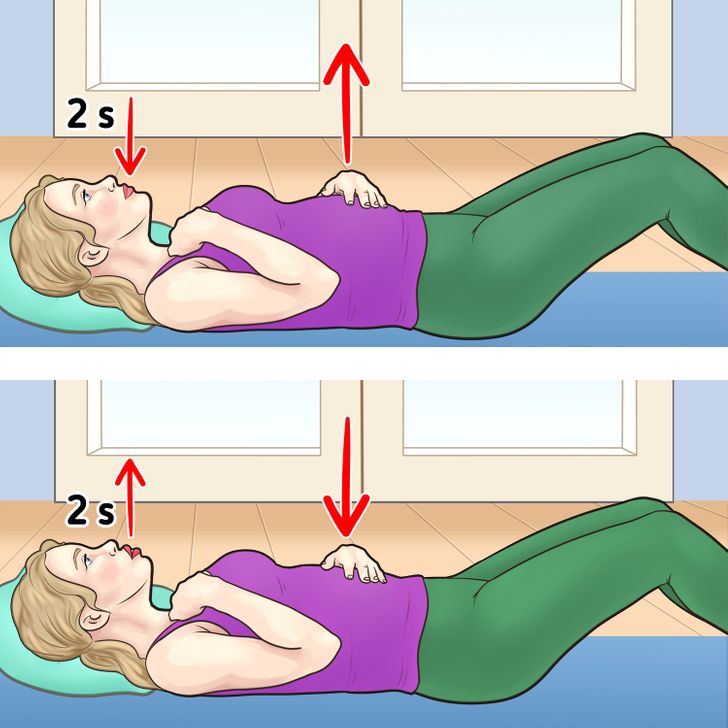
This breathing technique is pretty much the basis of all meditation techniques. The benefits linked to this practice are countless and they all have to do mainly with the fact that they help control anxiety and stress. Here are the steps you have to follow to perform this:
- Lie down on the floor, on your bed, or on any comfortable, flat surface with your knees slightly bent and your head resting on a pillow.
- Rest one hand on your upper chest and the other on your abdomen, this will allow you to feel the movement of your diaphragm.
- Inhale slowly through your nose for about 2 seconds and try to bring the air into your abdomen. You should feel your stomach press against your hand.
- Then, purse your lips and exhale slowly for about 2 seconds, now your hand should be pressing on your stomach as you tense it slightly. The hand that is on your chest should be completely still.
- The whole exercise should last between 5 to 10 minutes, and it is advisable to practice it 3 to 4 times a day.
Technique 3: Alternate nostril breathing
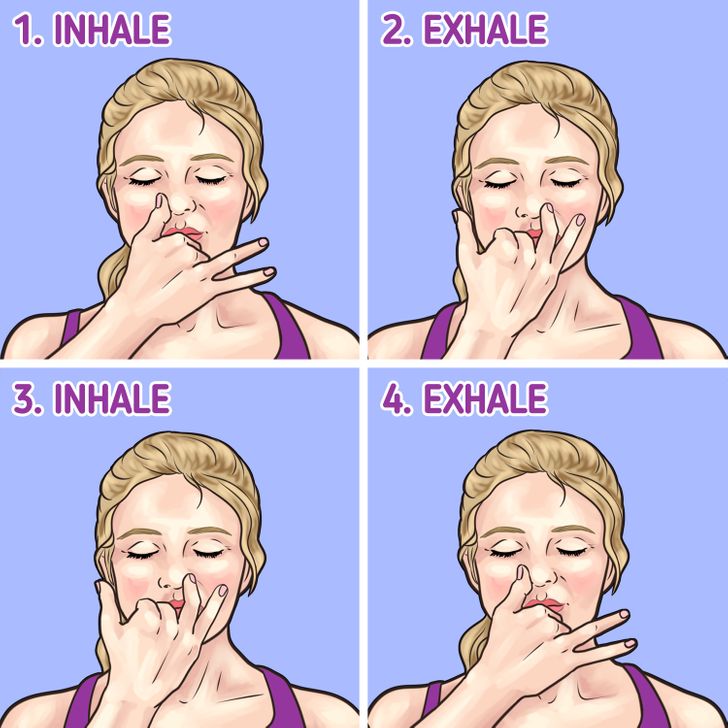
This is a breathing exercise widely practiced in yoga. It works very well when you’re trying to relax while at the same time looking to improve your concentration and replenish your energy. In fact, it works so well that it’s not really recommended to practice it before going to sleep, precisely because its objective is to make us feel more awake.
Here’s how you can practice this technique:
- Find a comfortable position, it can be on the floor or in a chair. Before starting, make a complete exhalation.
- Close your right nostril with the thumb of one hand.
- Inhale through the left nostril.
- Close the left nostril with the fourth finger and release the thumb.
- Exhale through the right nostril.
- Inhale through the right nostril, then close it with the thumb and release the fourth finger.
- Repeat this same cycle for about 5 minutes. Make sure to always finish the exercise exhaling through the left side.
It is better if you do it on an empty stomach, and you should not practice it if you are not feeling well or are congested. For the duration of the exercise, try to keep your breathing smooth and even.
Technique 4: Lion’s breath
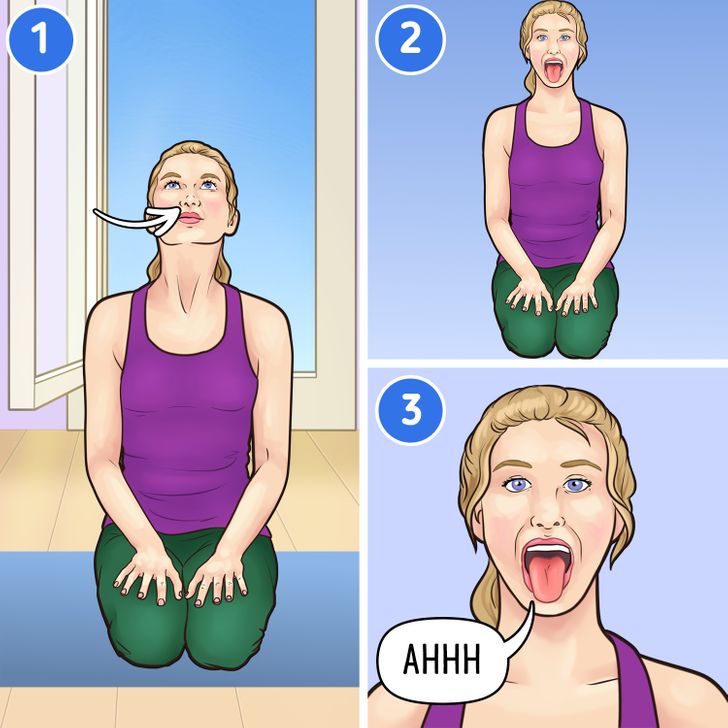
For this particular technique, you will combine facial stretches with some of the breathing exercises we’ve mentioned earlier. The goal is to relieve the tension that builds in your chest and face.
This is what you should do:
- Sit comfortably, you can cross your legs or lean on your heels.
- Rest the palms of your hands on your knees and press with your fingers wide open, then inhale deeply through your nose and open your eyes wide.
- As you do so, open your mouth and stick out your tongue, trying to bring the tip toward your chin.
- Exhale through your mouth making a long “aaah.” Try to contract the muscles in the front of your throat and look toward the space between your eyebrows or the tip of your nose.
- When you take a breath, relax your face as much as possible.
- Repeat the exercise up to 6 times.
Technique 5: Equal breathing
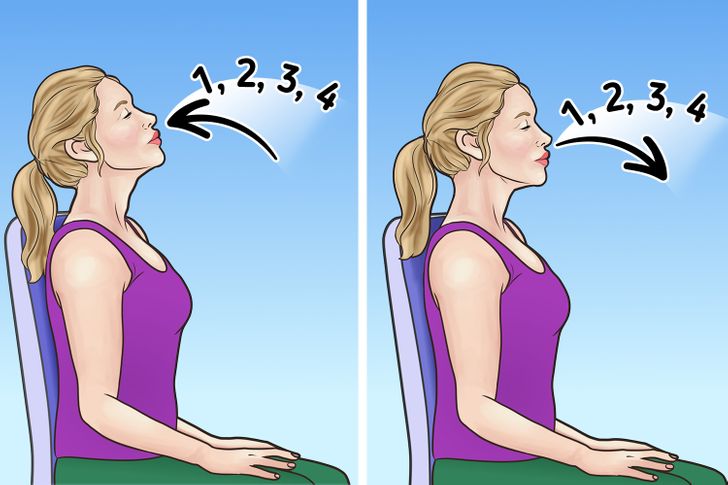
This breathing technique basically revolves around finding the perfect balance between the time of inhalation and exhalation, that is to say that both should last exactly the same amount of time. It is an ideal technique to practice before going to sleep. It works in a very similar way to “counting sheep” before going to bed. The length you choose for your inhaling and exhaling periods should be neither too short nor too long. The idea is for you to practice this technique on a regular basis so it is sustainable over time.
Tips on how to do it:
- Choose a comfortable position, you can sit in a chair or lie down.
- Inhale and exhale through your nose. To make the inhalation and exhalation last exactly the same amount of time, you can repeat a word or a short phrase while doing so, or count to 4.
- Over time, you can extend the breaths by counting to 6 or 8.
Technique 6: Mindful breathing
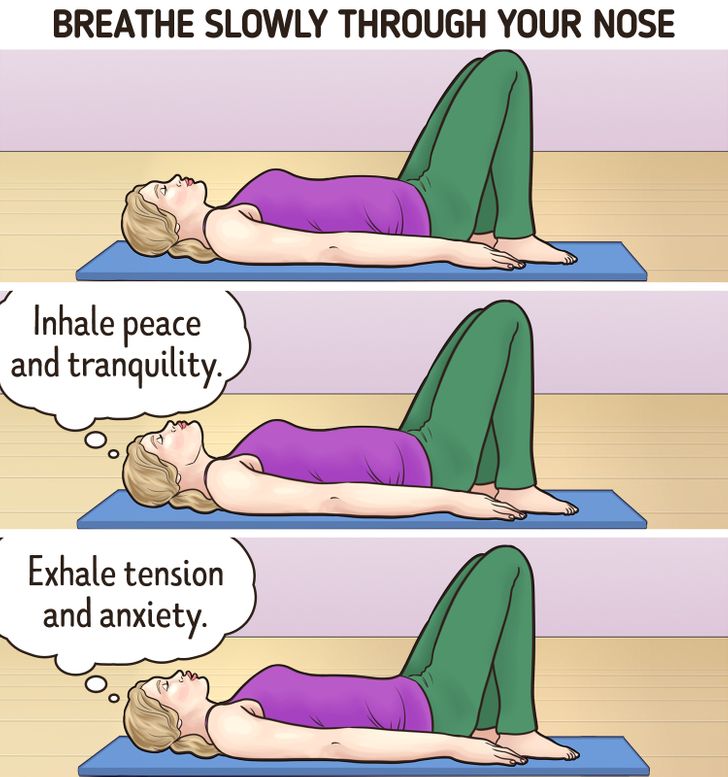
This is a deep breathing technique that uses words or messages as a means to help you focus and draw your attention to breathing and breathing only. It’s always better to choose a word that you consider good for concentration, something that draws your attention. In most cases, positive terms like “peace,” “let go,” “relax,” and “calm” are good options, but feel free to choose any word that you find suggestive and calming at the same time.
- Sit or lie down in a quiet, comfortable place.
- Concentrate on your breathing without altering it in any way, just observe how you are doing it.
- Breathe slowly and deeply through your nose.
- Notice how your belly and upper body expand.
- When you exhale, breathe out strongly, sighing as you do so. Continue for a few minutes, paying attention to the movement of your abdomen.
- Then, begin the deep breathing practice by vocalizing your chosen word each time you exhale.
- When you inhale, you can mentally repeat “inhaling peace and calm,” and when you exhale, “exhaling tension and anxiety.”
Start with 10-minute sessions, then you can gradually increase the time.
Technique 7: Sitali breath
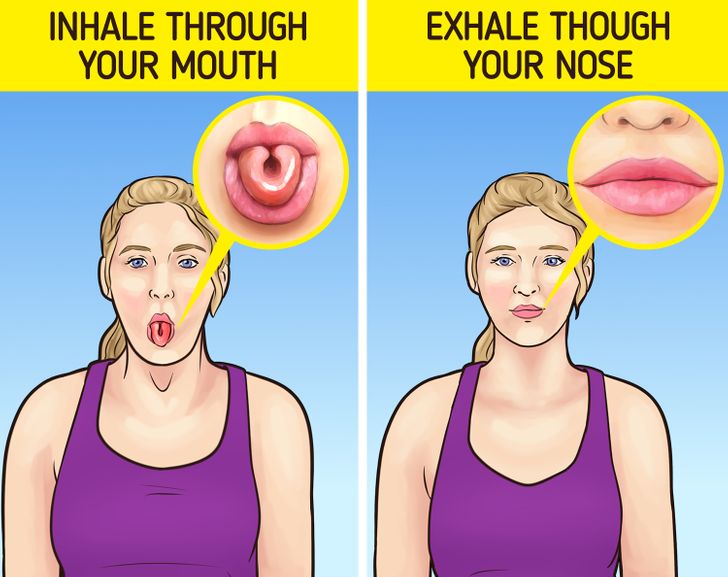
This particular technique is also a yoga breathing practice often used to lower the temperature of your body and to make you feel calmer. You can use it when you feel you are experiencing hot flashes, for example, but also when it’s very warm, like for instance during summer. It is said that, when done properly, it is almost as effective as an air conditioner. It involves taking in air slowly, by placing your tongue in a particular way that’s often known as rolling your tongue.
- Sit comfortably, relax your shoulders, and leave your chin parallel to the floor.
- Take 2 or 3 deep inhales and exhale through your nose before starting.
- Roll your tongue. Bend it toward the center, trying to form a sort of tube — if you can’t do it, pucker your lips and make the shape of an “o” with them. In this case, hold your tongue against the back of your lower teeth.
- Begin to inhale slowly through the tube you have formed with your tongue as if it were a light bulb. Bring the air into your chest and abdomen.
- Close your mouth and exhale slowly through your nose.
- Repeat the exercise 5 to 10 times.
Technique 8: 4-7-8 breathing
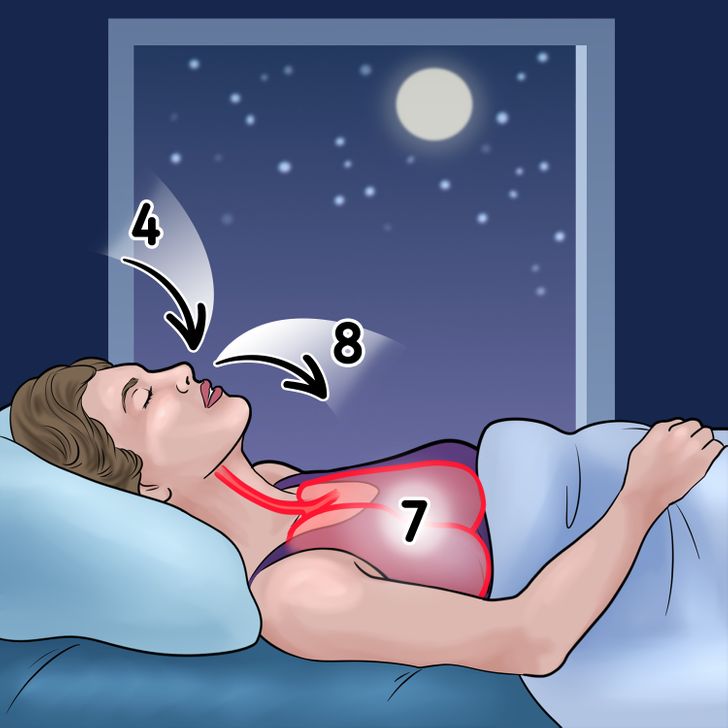
This technique is the perfect one to practice before going to sleep: it is said to help you fall asleep very quickly. Before starting, rest the tip of your tongue against the top of your mouth, relax your muscles, and exhale through your mouth completely until you feel that you have no more air left.
- Inhale through your nose for a count of 4.
- Hold your breath for a count of 7.
- Exhale forcefully through your mouth for 8 seconds. As you do so, purse your lips and make a humming sound.
- You can repeat this cycle up to 4 times.